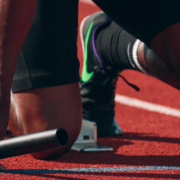No Pressure. No Diamonds.
By Geoff Heppes, Sports Blogger
The famous slogan “no pressure, no diamonds,” made popular by former Baylor and Washington Redskins quarterback (now currently with the Cleveland Browns), Robert Griffin III, describes how athletes cannot achieve greatness and be true champions without enduring some hard pressure. This idea definitely applies to arguably the two best Olympic athletes out of the staggering 555 that the United States sent out in swimmer Michael Phelps and gymnast Simone Biles.
First, Phelps, 31, is the most decorated Olympic athlete of all time, and possesses the most gold medals by any Olympic athlete in Olympic history. Phelps is the proud owner of 23 medals overall with 19 of them gold…currently. Currently because he will likely add to both of these large totals. While American golden boy Phelps carried out the flag leading the Americans into the Olympics, has a beautiful fiancé and child and seems very well put together overall, his past is sad and troubling.
After hauling in eight gold medals in a sweep of every event he swam in the 2008 Beijing Olympic Games, Phelps thought about walking away from swimming completely; this lead to Phelps losing his purpose in life. Phelps had a meltdown and since then accumulated two DUI offenses, used marijuana, still had not spoken to his father since he was nine years old and thought about taking his life. Then, a special friend came along and spoke to Phelps.
After talking to close friend and soon to be Hall-of-Fame Ravens linebacker, Ray Lewis (also an amazing motivational speaker and Christ-follower), Phelps turned his life around. Phelps checked into rehab and spent 45 days there and cleansed himself of temptations of marijuana and alcohol abuse. Phelps later recommitted himself to Jesus, and he also spoke to his dad and mended that relationship after decades of tension. Phelps is now swimming again for gold medals in Rio and looking better than ever.
Biles, 19, is probably the best gymnast in the world with former American Olympic great, Nastia Liukin, calling her “untouchable.” Biles most recently won gold for best female all-around gymnast, and is favored to take home up to five gold medals. Biles has competed with great power, serene grace and elite poise, but her haunting past is hard to deal with.
Biles biological mother, Shannon Biles, 44, gave Simone up for adoption when she was six years old due to Shannon’s addiction to drug and alcohol abuse. Simone and her younger sister, Adria, were put into foster care in Ohio until they were adopted by Shannon’s biological parents, Simone and Adria’s grandparents, Ronald and Nellie Biles. Simone refers to Ronald and Nellie as her parents.
Simone now has a more open dialogue with her mother, as she has been sober since 2007, and both her and her former struggling as well father, Kelvin Clemons, both are incredibly proud of their accomplished biological daughter, and have tremendous respect for Ronald and Nellie and how well they have raised Simone and Adria.
Both Phelps and Biles have overcome a tremendous amount of adversity in their lives, and are brave enough to let the world know about it; their challenges they have overcome have made them stronger than they ever could have been without it. With great support systems, hard work and dedication to their respective sports and a little pressure, these two elite athletes are true diamonds, gold diamonds might I add.




